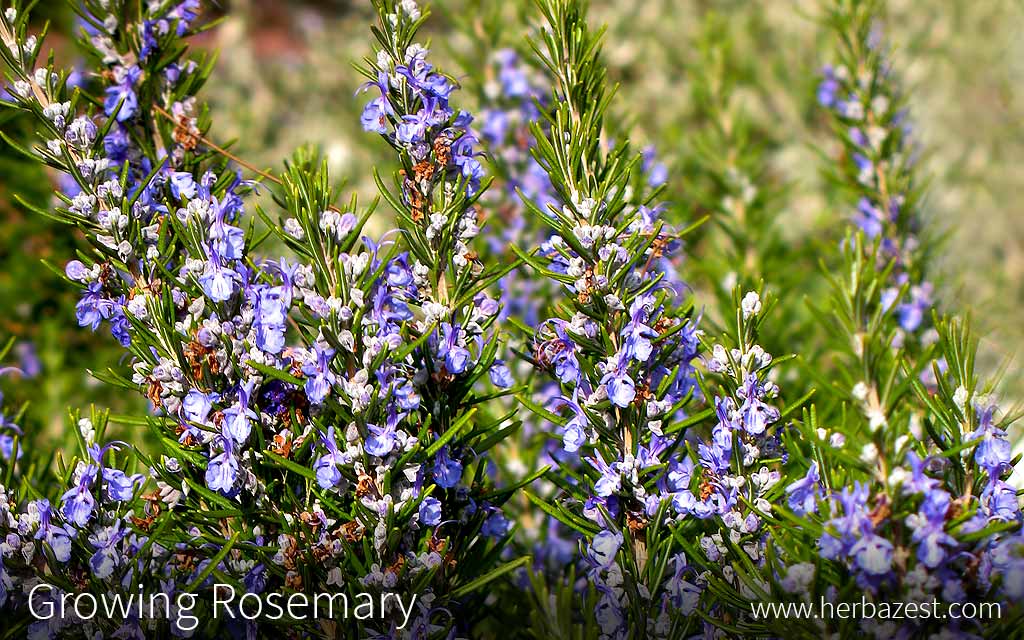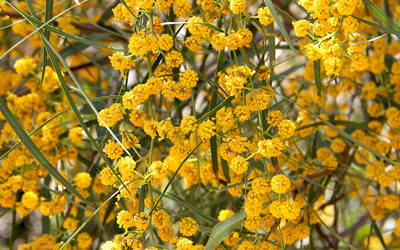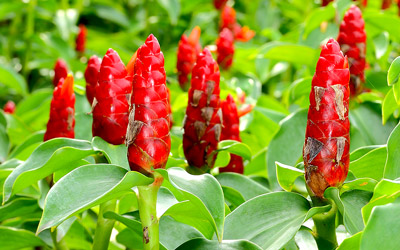Rosemary is a hardy plant, drought resistant, and can survive a light freeze, but it may need to be protected in colder areas. It can be grown as an annual or a perennial evergreen. The following growing guidelines will help you to cultivate this aromatic plant in your own garden or backyard.
1. Preparing the Soil
Like other Mediterranean herbs, rosemary prefers temperate climates (U.S. hardiness zones 8 - 10), and most varieties grow best in well-drained, loamy sand, and slightly acidic soil, with a pH of 6.0 - 7.0. It needs days with six to eight hours of full sun to thrive and also tolerates partial shade, but the lack of sunlight will slow-down its normal development.
Before planting rosemary, the area should be cleared of rocks, weeds, and plant debris. It is recommended to analyze pH levels and amend the soil, if necessary, with compost or organic matter. Excessively acidic soils can be balanced by adding lime.
Depending on the soil test results, about four inches (10 cm) of organic matter or compost can be mixed to a depth of six to eight inches (15 - 20 cm). Good drainage is important for rosemary to grow healthy. This can be provided by planting it in raised or slightly mounded beds.
2. Planting
Planting Rosemary Outdoors
Rosemary can be propagated by seeds; however, they have a low rate of germination (about 15%), and the plant will have a better chance to succeed if grown from cuttings or seedlings bought in a local nursery.
When seedlings are three inches (8 cm) tall or indoor cuttings have developed a good root system, they should be planted in their permanent position three to four feet (90 - 122 cm) apart or in individual garden containers.
An important thing to know about rosemary beforehand is that it comes in different sizes and shapes. Some plants are tall and upright, and look great in hedges or dry borders, while others are dwarf cultivars which are often used as ground covers and can do great both indoors and outdoors.
Rosemary tall varieties can reach up to six feet (1.82 m) tall and four to five feet (1.22 - 1.52 m) wide when planted in the ground but will remain smaller if pruned or planted in containers.
Planting Rosemary Indoors
The best way to propagate rosemary is starting it indoors, from cuttings taken from an established, vigorous rosemary shrub. A three-inch (8 cm) branch should be clipped from the stem of the plant and be stripped from its lower leaves at least 1.5 inches (4 cm) up from the base of the stem.
In order to prevent the cuttings from wilting, they should be placed in water immediately after being removed from the plant.
One or two cuttings should be planted into a three-inch (8 cm) container filled with mixture of clean sand, peat, and perlite. The container should be watered thoroughly and placed in a windowsill with indirect sunlight and constant temperatures of 60 - 70°F (15.5 - 21°C). After about eight weeks, the cuttings will be ready for transplanting to their permanent location.
It is possible to grow rosemary indoors, in a cool (even cold) sunny spot where the humidity is high. If the plant don't receive enough sunlight and moist, its leaf tips will turn brown and it will dry out quickly. On the other hand, over-watering should be avoided, since it can damage and ultimately kill the plant.
Rosemary can be grown in clay or plastic containers; however, clay pots do not retain humidity as long as plastic containers do.
3. Plant Care
Watering
During its development phase, rosemary needs to be watered frequently (every three to five days). After few months, when the root system has been established, rosemary plants will require little to moderate amounts of water. Frequent misting is helpful; however, the soil must be kept on the dry side.
When it comes to indoor containers, rosemary in clay pots need to be watered often, since the plants will dry more quickly. Micro irrigation systems are a good way of providing moisture to outdoor containers.
Fertilizing
Rosemary is a hardy evergreen; it can do well in poor conditions and does not require to be fertilized frequently. A slow release balanced fertilizer is beneficial to use in spring and summer, which are the best growing months for rosemary.
Pruning
When rosemary plants are young their tips can be pruned periodically, and older plants will benefit from regular pruning to keep their shape and remove old growth.
Pruning the plants will encourage a tight compact habit. For ornamental purposes, rosemary plants can also be shaped into forms resembling small evergreens.
Weed Control
The base of rosemary should be free of weeds or other plants growth. This can be done by hand weeding and mulching around with wood chips, bark chips, sawdust, or compost, with or without fabric barriers.
Care should be taken to keep the mulch layer 6 - 12 inches (15 - 30 cm) away from the base of rosemary. The garden lawn should not be allowed to grow within a foot or two of the plant. If taking proper care of rosemary herbicides should not be necessary.
4. Pest & Disease Control
Rosemary is fairly resistant when compared to other aromatic herbs. However, aphids, spittlebugs, and whiteflies are common threats to the plant, as well as diseases such as powdery mildew and root rot.
Pests
Rosemary aphids are small, dark insects that feed on the leaves and produce a sticky substance, which can turn black and attract fungal growth. Aphids can cause the leaves to curl and stunt the growth of the plant.
The best control for aphids may be to prune out the affected areas and get rid of the debris. Most insecticides will eliminate these bugs; however, care should be taken since rosemary attracts a variety of pollinators that can be affected by the harmful chemicals. Natural enemies, such as parasitic wasps and lady beetles, are biological forms of control that will not damage the plant or the environment.
Spittlebugs are inconspicuous, often greenish or brownish insects that also feed on rosemary juices. Adult females lay small eggs in rows in hidden parts of the plant, such as the sheath between leaves and stems. Once they hatch, the nymphs hide on what it looks like a spittle mass. Infestations distort plant tissue and slow growth.
Spittlebugs do not usually cause a lot of damage. They can be just washed off of handpicked. A good way of controlling this pest is also to cut weeds and check for the presence of these insects in neighboring woody plants in order to wash them off in the spring, before they mature and spread.
Whiteflies, which are not really flies but are more related to mealybugs and aphids, develop rapidly in warm conditions, and infestations can occur in the absence of natural enemies and when weather and host plants favor outbreaks. Whiteflies suck the sap of rosemary and excrete a sugary liquid, which make the leaves look sticky or covered with dark mold.
This pest is not particularly damaging for woody plants like rosemary, but it can transmit pathogens such as fungus. Removing infested leaves or watering off these bugs will help control population, as well as increasing the presence of natural enemies and removing host plants.
Diseases
Whether rosemary is grown indoors or in the garden, using clay containers may help avoid root rot, and powdery mildew can be prevented by ensuring proper aeration between plants and avoiding overhead watering. It would be a good idea to place the rosemary plants in full sun and protect them with fungicide sprays in humid conditions.
5. Harvest
Rosemary can be harvested and dried in the sun without loss of much of its green color. The tender tips and foliage can be cut as needed throughout the growing season, but they should be allowed to replace their growth between harvests. Some varieties are valued for their small flowers, which are harvested to be used in salads.
6. Storage
There are several ways to preserve rosemary but it always should be thoroughly washed and patted dry beforehand. Using fresh rosemary leaves, removed from the woody stems, is an option for many recipes, as well as for making a warm, soothing infusion.
Leaves can be dried and stored for later use. Food dehydrators dry herbs at low temperatures for a long period of time to help retain flavor. Once the rosemary has been dried, it needs to be stored it in an airtight container in a cool, dry place.
Rosemary can also be microwaved dry. After removing the stems, the leaves should be placed in a paper towel and put into the microwave for a minute or so. Thicker leaves may take a bit longer.
With herbs like rosemary, thyme and dill, it is best to freeze the leaves while still on their stalks.
Another way of preserving rosemary is placing it in single layer on a baking sheet and frozen. Once it is frozen, rosemary can be stored in airtight bags and kept in the freezer.
Occasionally, longer, woody stems can be harvested and used as skewers for grilling meat and vegetables. In that case, the branches should be soaked in water for a few hours prior to grilling to prevent burning.
Rosemary is a very easy herb to grow and take care of. It will grace any garden with its aromatic scent and pretty flowers, and will also be available all-year-round to be used in a variety of culinary and medicinal recipes.





